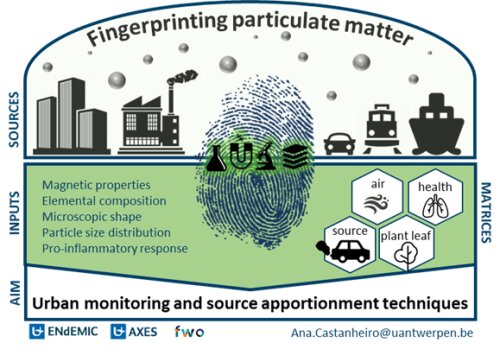The Particulate Matter Fingerprint (PMF) project: towards biomagnetic monitoring for source attribution of urban PM and associated early-health effects
Among air pollutants, particulate matter (PM) poses the greatest risk to public health. Atmospheric PM is currently monitored by a network of air monitoring stations, but its limited spatial resolution impedes to properly monitor the high spatial variability in PM local exposure. On the other hand, urban vegetation works as a reliable passive PM collector, as it provides a natural surface for deposition and immobilization of pollutants. In this research project, urban green is used as a bio-indicator for atmospheric PM (biomonitoring), where each leaf plant can work as a monitoring station per se. Within airborne PM, iron and other metals are of particular interest. Therefore, magnetic biomonitoring of leaves has been extensively used as a rapid and cost-effective tool to assess urban PM exposure. The discrimination of PM sources based on magnetic analyses remains yet a less explored topic, which is developed in this PMF – Particulate Matter Fingerprint – project.
PM source attribution mainly depends on the chemical characteristics (composition and structure of the particles), size distribution and even shape properties, therefore, a component of particle analysis and physical/chemical properties is necessary to understand the different sources of PM. The strategy of this project is based on fingerprinting the major urban PM sources (e.g. roadside and train traffic) in terms of its magnetic signatures, composition and microscopic form, and on how the different magnetic parameters can be used to identify them in the mixed-source urban environment. Pursuing a holistic characterization of the studied PM sources, our experiments include the entire pathway by collecting samples of direct sources – air – plant leaves. Other health-relevant atmospheric pollutants are monitored (e.g. BC) in addition to PM, and the toxicity of the targeted PM sources are also included. The main goal is then to investigate the applicability of using magnetic biomonitoring of urban leaves as an effective source apportionment methodology/tool for PM exposure assessment. The application of such a methodology can help on delineating high-polluted PM areas while understanding their major PM emission sources, which can be of great use for e.g. impact assessment studies and policy implementation of targeted PM mitigation strategies.
This joint project has been developed by ir. Ana Castanheiro [AC1] and dr. Jelle Hofman[AC2] with promotor Prof. Roeland Samson[AC3] , and in collaboration with several UA and external partners. Further information can be found on the project’s ResearchGate[AC4] .

Relevant articles to include:
Moretti, S., Smets, W., Hofman, J., Mubiana, K.V., Oerlemans, E., Vandenheuvel, D., Samson, R., Blust, R., Lebeer, S., 2019. Human inflammatory response of endotoxin affected by particulate matter-bound transition metals. Environ. Pollut. 244, 118–126. https://doi.org/10.1016/J.ENVPOL.2018.09.148
Hofman, J., Maher, B.A., Muxworthy, A.R., Wuyts, K., Castanheiro, A., Samson, R., 2017. Biomagnetic Monitoring of Atmospheric Pollution: A Review of Magnetic Signatures from Biological Sensors. Environ. Sci. Technol. 51, 6648–6664. https://doi.org/10.1021/acs.est.7b00832
Baldacchini, C., Castanheiro, A., Maghakyan, N., Sgrigna, G., Verhelst, J., Alonso, R., Amorim, J.H., Bellan, P., Bojović, D.Đ., Breuste, J., Bühler, O., Cântar, I.C., Cariñanos, P., Carriero, G., Churkina, G., Dinca, L., Esposito, R., Gawroński, S.W., Kern, M., Le Thiec, D., Moretti, M., Ningal, T., Rantzoudi, E.C., Sinjur, I., Stojanova, B., Aničić Urošević, M., Velikova, V., Živojinović, I., Sahakyan, L., Calfapietra, C., Samson, R., 2017. How Does the Amount and Composition of PM Deposited on Platanus acerifolia Leaves Change Across Different Cities in Europe? Environ. Sci. Technol. 51, 1147–1156. https://doi.org/10.1021/acs.est.6b04052
Castanheiro, A., Samson, R., De Wael, K., 2016. Magnetic- and particle-based techniques to investigate metal deposition on urban green. Sci. Total Environ. 571, 594–602. https://doi.org/10.1016/j.scitotenv.2016.07.026
Hofman, J., Stokkaer, I., Snauwaert, L., Samson, R., 2013. Spatial distribution assessment of particulate matter in an urban street canyon using biomagnetic leaf monitoring of tree crown deposited particles. Environ. Pollut. 183, 123–132. https://doi.org/10.1016/j.envpol.2012.09.015
Hofman, J., Wuyts, K., Van Wittenberghe, S., Samson, R., 2014. On the temporal variation of leaf magnetic parameters: Seasonal accumulation of leaf-deposited and leaf-encapsulated particles of a roadside tree crown. Sci. Total Environ. 493, 766–772. https://doi.org/10.1016/j.scitotenv.2014.06.074
Hofman, J., Wuyts, K., Van Wittenberghe, S., Brackx, M., Samson, R., 2014. Reprint of on the link between biomagnetic monitoring and leaf-deposited dust load of urban trees: Relationships and spatial variability of different particle size fractions. Environ. Pollut. 192, 285–294. https://doi.org/10.1016/j.envpol.2014.05.006
Hofman, J., Samson, R., 2014. Biomagnetic monitoring as a validation tool for local air quality models: A case study for an urban street canyon. Environ. Int. 70, 50–61. https://doi.org/10.1016/j.envint.2014.05.007
[AC1]https://www.uantwerpen.be/en/staff/ana-castanheiro/
[AC2]https://www.uantwerpen.be/en/staff/jelle-hofman/
[AC3]https://www.uantwerpen.be/en/staff/roeland-samson/
[AC4]https://www.researchgate.net/project/Implication-of-biomagnetic-monitoring-in-urban-air-quality-assessments-composition-and-health-relevance-of-the-magnetisable-particulate-matter-fraction